I know I promised last post that I would talk about dialogue this week, but I got distracted and had a hard time taming the post. Next time.
This week, inspired by the classic John Miller piece posted a little while ago about guns and cordite and stuff, I thought I would continue the theme with a post about bullets and their behavior. Let’s start by recognizing that virtually everything you’ve ever seen on television regarding bullet behavior and the damage they cause is wrong. No matter how tough a tough guy is, if he’s been shot in the leg and his leg is broken, he cannot walk on it–except maybe if it’s a fibula (ask John Wilkes Booth about that). Remember all those heroes of our youth who were “only” shot in the shoulder, and then were back in action by the epilogue with his arm in a sling? Well, here’s what a shoulder joint looks like:
There’s no place for a bullet to go that would not shatter a bone or three. Not to mention the complex arrangement of blood vessels in there that are just waiting to get torn up. Torn blood vessels bleed. If the bleeding can’t be stopped, the victim dies. Blood loss is the primary cause of fatalities when bullets are involved.
The Myth That Caliber Equals Stopping Power
Here’s a selection of common pistol bullets:
From left to right, the bullets are .410; .38 Police Special; .45 ACP; .40 ACP; 9mm Luger; .380 ACP; .25 ACP; .22 Long Rifle. The ACP suffix stands for “automatic Colt pistol” because that was the first firearm to use that shell casing design. The decimals refer to the diameter of the bullet at its widest point (and remember, the bullet is the nosecone atop the shell casing), measured in inches. A .45, then, is 45/100 of an inch at its widest point. You’ll also see bullets measured in millimeters. Thank NATO for that.
And here is an assortment of rifle bullets:
From left to right: .300 WinMag (Winchester Magnum–a sniper round); 7.62mm; 5.56mm (used in M16s, AR15s; M4s); 4.6mm (used mainly by Special Forces and specialized units); .22 Long Rifle. Without getting too deeply into gun porn, it’s important to note that two of these NATO rounds–noted by the metric measurement–have caliber equivalents: 7.62mm=.308 caliber; 5.56mm=.223 caliber.
Note, then, that both of these bullets are .22 caliber:
So, there’s more to bullet energy than caliber. The amount of propellant and the weight of the bullet, usually measured in grains, have a lot to do with the lethality of a bullet. The rest of the lethality equation has everything to do with shot placement. A small bullet, properly inflicted, will do more harm than a poorly aimed big bullet. Ronald Reagan and George Wallace were both critically wounded by that little bitty .22 long rifle round, and Bobby Kennedy was killed with one.
Kinetic Energy
Most modern bullets travel at supersonic speeds. Since the speed of sound represents the speed at which air molecules can get out of each other’s way a bullet in flight creates a pressure wave at its nose, and because Mother Nature abhors imbalance, that positive pressure at the nose creates a negative pressure at the tail. When a bullet hits a person, the pressures surrounding the projectile do an enormous amount of damage to surrounding tissues.
Here’s a slow motion video of a 9mm pistol bullet impacting ballistic gelatin, which is designed to simulate the consistency of human flesh:
See how that wound channel opens and snaps shut? Imagine that all of that energy was being absorbed/inflicted on a liver. Getting the bullet out is far from the most pressing emergency in many bullet wound cases.
Here’s a similar video showing the damage inflicted by a .308/7.62mm rifle bullet:
So, yeah. A bigger, heavier bullet traveling at a much greater speed causes a heck of a lot more damage. The reason you’re able to see such pronounced spiraling in that video is because the bullet is a hollow point, which is designed to open up on impact. This is what a hollow point bullet looks like before it’s fired:
The common alternative to a hollow point is a full metal jacket, which looks like this:
While the hollow point undoubtedly inflicts more damage upon the person it hits, the true purpose of the bullet’s design is to prevent over-penetration, where a bullet intended for a bad guy would not travel through-and-through to hit the good guy standing behind him.
We talk about research quite a lot here at TKZ, and I recommend that anyone who writes about this stuff in their stories take some time to visit your local gun store or go to a gun show. You’ll find lots of very nice folks who love to talk about all things firearms related. Many gun stores will let you rent a gun and fire it on their range. If you’re not comfortable handling them, no problem. They’ll be happy to help you out.
Just remember rules:
- Assume that every gun is loaded, even when you’re certain it is not;
- Never point the muzzle at anything you’re not wiling to destroy; and
- Don’t touch the trigger until you’re sure you’ve acquired your target.

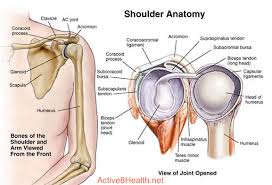
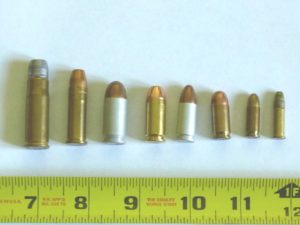
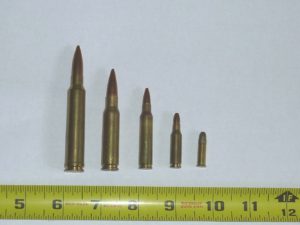
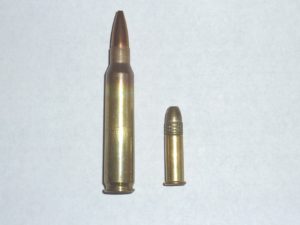
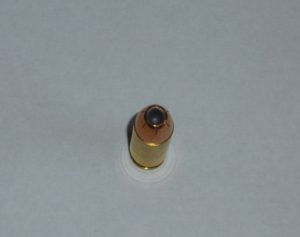
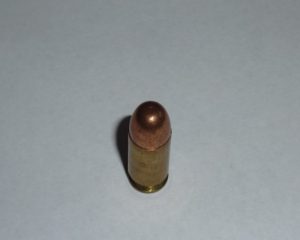
Hi John,
Thanks for a good clear explanation w/o going overboard. FYI, the videos did not work.
Love this, John. Very helpful. Am still learning about weapons but I know enough to know I don’t know enough ,and I run everything guns by my expert when I need book help.
You will find this interesting…I was reading a story in the paper the other day about militia guys out training for the end of the world and the reporter of the vaulted New York Times actually wrote: “The smell of cordite hung in the air.”
Argh. Maybe reporters should go to a gun range and learn something as part of their journalistic training.
I think that cordite is one of those words that has been used improperly for so long that people have stopped thinking of it as a real thing.
Thanks for this! I am always looking for reliable sources of information on injuries so I don’t end up writing them like “in the movies.” But I can only stand so many forensics photos and reports . . .
There’s a pretty stunning local news story from my area (West Michigan) that offers a counter-reminder of how unpredictable the effects of bullets can be. During a random assault and attempted robbery, a 47-year-old professor suffered a gunshot wound, with the bullet entering directly below his ribs and exiting his back. Yet no internal organs were damaged, and he was back at work in a few days (full recovery obviously took much longer). You can read the story here, if you want: http://www.mlive.com/news/grand-rapids/index.ssf/2016/08/calvin_college_professor_shot.html
Very good point. Back in my firefighter/EMS days, there were a number of those weird kinds of cases. I always figured that God wasn’t quite ready for them that day.
Excellent post, John! Accurate information clearly presented. I’m saving this post.
Carol
Spectacular post. Bringing back the “Kill” part in the KillZone.
Obliged.
I’d love to have more genre-specific posts appearing regularly. In fact, I’m just going to put it out there: Given that James Scott-Bell has pretty much covered all major fiction pillars, he should now move to publishing a tome on the craft of writing a murder mystery, in his trademark authoritative and insightful style.
I know I’d double dip.
I love that you point out that those with broken legs don’t get up and walk, let alone run, away. One of my pet peeves in so many movies (and books) is people having devastating injuries and still continuing to fight, run, pretty much act like nothing has happened except for a wince. As someone who’s had numerous injuries I know it’s just not possible.
Note to those having problems with the videos: it may be your permissions, or your software version. I had to allow Silverlight for this, and once I did they both played just fine.
Thanks for the suggestion on Silverlight. A notice did come up that it was out of date and needed upgrading, but I ignored it.
I was wondering why you left out the .32 ACP.
My stories take place in Boston in the 1954-1955 time period. (Book 1, “The Conrad Kidnapping”, is available on Amazon. Book 2, “Pepper Creek Murder”, will be available soon on Amazon)
I digress, anyway, my detective (Mark Steele) carries a 1934 Mauser in .32 cal. A pistol he was given, as a gift, in payment, by a german lady, for helping her locate some family heirlooms, stolen from her family shortly after the war.
The Mauser is reliable, and the .32 is nearly as effective as a .38 (in tight situations) and the pistol is slightly lighter to carry.
The type if cases my detective gets involve in doesn’t require the firepower of a .45, like the hard-boiled detectives like Mike Hammer carries.
That should be German, not german—sorry that slipped by me.
Hi, Tom. The pictures all came from my own personal collection, and I don’t have a .32 caliber bullet. It is certainly a respectable round, but man oh man it’s expensive!
All i can say about the price is that I don’t have to buy them today, just write about them. In 1954 they were much cheaper.